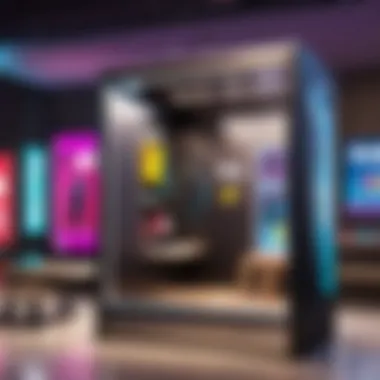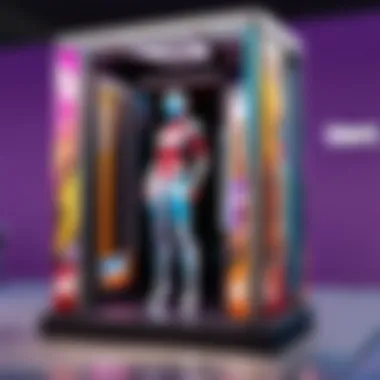Unveiling the Evolution of Changing Booths: A Retail Revolution


In the realm of retail, the metamorphosis of changing booths unveils a compelling narrative that reflects the ever-evolving landscape of consumer experiences and technological advancements. From the traditional confines of fitting rooms to the avant-garde realm of virtual try-on encounters, the journey of changing booths encapsulates a profound shift in how individuals engage with products and services within the retail sphere.
Overview of Recent In-Store Innovations
The trajectory of retail changing booths has witnessed a renaissance in recent years, propelled by a wave of innovative designs and cutting-edge technologies. These advancements have not only redefined the physical space of traditional fitting rooms but have also revolutionized the way customers interact with and perceive the act of trying on clothing. As retailers strive to create immersive and personalized experiences, the emergence of smart mirrors, interactive displays, and virtual reality integration has paved the way for a new era of in-store shopping.
Integration of Technology and Design in Changing Booths
Central to the evolution of changing booths is the seamless fusion of technology and design, where functionality meets aesthetic appeal in a harmonious blend. The incorporation of RFID tagging, augmented reality applications, and body scanning technologies has streamlined the fitting process, providing customers with customized recommendations and enhancing their overall shopping experience. Moreover, the integration of sustainable materials and eco-friendly designs reflects a shift towards conscious consumerism and environmental stewardship in retail spaces.
The Psychology of Fitting Rooms
Beyond the mere functionality of trying on clothes, fitting rooms delve into the realm of consumer psychology, influencing purchasing decisions and brand loyalty. The ambiance, lighting, and layout of changing booths play a pivotal role in shaping the perception of a brand and creating a conducive environment for customers to make confident choices. Understanding the psychological nuances of fitting rooms is imperative for retailers seeking to optimize sales and forge deeper connections with their target audience.
Personalization and Virtual Fitting Experiences
In an era where customization and personalization reign supreme, virtual fitting rooms have emerged as a game-changer in the retail landscape. By leveraging 3D modeling, AI-driven algorithms, and virtual try-on technologies, customers can now visualize how clothing items will look and fit without physically trying them on. This fusion of digital innovation and personalization not only increases engagement and convenience but also reduces the need for physical returns, enhancing operational efficiency and customer satisfaction.
The Future of Changing Booths
As retail continues to embrace digital transformation and immersive technologies, the future of changing booths holds boundless possibilities. From AI-powered styling recommendations to interactive displays that blur the lines between offline and online shopping, the evolving landscape of retail changing booths is poised to redefine the very essence of the in-store experience. By staying at the forefront of technological innovation and consumer trends, retailers can unlock new avenues of engagement and reshape the narrative of traditional brick-and-mortar shopping.
Introduction
Retail spaces have undergone a significant evolution over the years, with changing booths playing a crucial role in this transformation. From traditional fitting rooms to innovative virtual try-on experiences, the changing booth landscape in retail reflects the dynamism of the industry. This article delves deep into the journey of these changing booths, examining how design, technology advancements, and shifting consumer behaviors have influenced their development. By exploring the evolution of changing booths, we can gain insights into the broader changes within the retail environment.
Evolution of Retail Spaces
Historical Perspective
The historical perspective of retail spaces provides a foundational understanding of how changing booths have evolved over time. Analyzing the roots of changing booths allows us to appreciate the significance of past design choices and their impact on modern practices. By examining the historical context, we can identify key elements that have shaped the current landscape of retail changing facilities. Understanding the historical perspective offers valuable insights into the evolution of consumer-centric experiences within retail settings.
Current Trends
Exploring the current trends in retail spaces sheds light on the latest practices and preferences shaping changing booths. By identifying and analyzing existing trends, we can pinpoint areas of innovation and improvement in contemporary retail environments. Current trends offer a glimpse into the evolving needs and expectations of both retailers and consumers, driving the constant evolution of changing booths towards enhanced efficiency and customer satisfaction.


Future Projections
Looking forward, future projections delve into potential advancements and developments that could redefine the concept of changing booths in retail settings. By projecting future trends, we can anticipate upcoming technologies and design approaches that might revolutionize how consumers interact with changing facilities. By exploring future projections, we aim to navigate the possibilities of integrating cutting-edge solutions to enhance the overall shopping experience.
Significance of Changing Booths
Impact on Customer Experience
The significance of changing booths in retail lies in their direct impact on customer experience. The design and functionality of these spaces play a critical role in shaping how consumers engage with products and brands. Understanding the influence of changing booths on customer experience helps retailers optimize these areas to create seamless and enjoyable shopping journeys for their clientele.
Role in Purchase Decision
Changing booths play a crucial role in the purchase decision-making process for consumers. The convenience, comfort, and privacy offered within these spaces can significantly influence whether a customer decides to proceed with a purchase. Recognizing the importance of changing booths in guiding purchase decisions underscores their strategic importance in driving sales and fostering customer loyalty.
Integration of Technology
The integration of technology has revolutionized the design and functionality of changing booths, offering interactive and personalized experiences for shoppers. By incorporating advanced tech solutions such as virtual try-on tools and smart mirrors, retailers can elevate the efficiency and engagement level of their changing facilities. Exploring the integration of technology in changing booths showcases the evolving relationship between retail spaces and digital innovations, paving the way for a more connected and immersive shopping experience.
Traditional Changing Booths
In the realm of retail settings, traditional changing booths play an essential role in facilitating customer experiences and purchase decisions. These dedicated spaces have been pivotal in the evolution of the retail industry, offering a platform for customers to physically engage with products before making a buying choice. Understanding the design elements, benefits, and considerations associated with traditional changing booths is crucial in appreciating their significance. The layout, lighting, mirrors, and privacy features of these booths contribute to creating a comfortable and practical environment for customers to try on clothing and assess their fit and style. As technology advances, traditional changing booths have adapted to meet changing consumer needs, blending functionality with aesthetic appeal.
Design Elements
Layout and Space Utilization
When it comes to traditional changing booths, the layout and space utilization are key factors that dictate the overall customer experience. The strategic arrangement of mirrors, hooks, seating areas, and fitting rooms within a retail space can optimize the flow of customers and enhance browsing and trying-on activities. Efficient space utilization ensures that customers have adequate room to move around, try on various garments, and engage with store offerings seamlessly. By prioritizing layout and space utilization, retailers can maximize the use of their physical floor space and create a visually appealing and functional environment for shoppers.
Lighting and Mirrors
The lighting and mirror features within traditional changing booths are pivotal in creating an ambiance that mirrors natural lighting conditions and complements different skin tones. Well-placed lighting fixtures eliminate shadows and provide accurate color representation, allowing customers to make informed decisions about their purchases. Additionally, mirrors play a dual role by reflecting the customer's image and enhancing the overall aesthetics of the fitting room. By incorporating high-quality lighting and mirrors, retailers can elevate the shopping experience, boost customer confidence, and increase the likelihood of a successful sale.
Privacy Features
Privacy features within traditional changing booths are designed to offer customers a sense of security and comfort during the try-on process. From sturdy doors and curtains to soundproofing materials, these features ensure that customers can engage with items without the fear of intrusion or judgment. Privacy features play a crucial role in enhancing customer satisfaction, encouraging longer browsing times, and fostering a trusting relationship between shoppers and the retail establishment. By prioritizing privacy in changing booths, retailers can create a welcoming and inclusive environment for customers of all backgrounds.
Consumer Behavior


When delving into the realm of consumer behavior within traditional changing booths, several aspects emerge that influence purchasing decisions and overall satisfaction. Understanding try-on habits, feedback and suggestions, and challenges faced by customers can provide valuable insights for retailers looking to enhance their changing room experience.
Try-On Habits
Customers often exhibit specific try-on habits when engaging with traditional changing booths, from selecting multiple sizes to experimenting with different styles and fits. By observing these habits, retailers can tailor their product offerings and display strategies to cater to customer preferences, ultimately leading to increased sales and customer loyalty.
Feedback and Suggestions
The feedback and suggestions received from customers after using traditional changing booths present an opportunity for retailers to refine their in-store experiences. By actively seeking feedback on lighting, mirror placement, seating comfort, and overall ambiance, retailers can make targeted improvements to enhance customer satisfaction and optimize the try-on process.
Challenges Faced
Despite the benefits traditional changing booths offer, certain challenges may arise, such as space constraints, maintenance issues, and cleanliness concerns. Addressing these challenges proactively can lead to a more streamlined and customer-centric changing room experience, ensuring that customers feel valued and empowered during their visit.
Technological Advancements
Technological advancements play a pivotal role in the evolution of changing booths in retail settings. With the rapid progression of technology, retail spaces have embraced innovative solutions to enhance customer experiences, streamline operations, and stay competitive in the market. The integration of technology such as virtual try-on solutions and smart mirrors has revolutionized traditional fitting rooms, offering a blend of convenience and personalization.
Virtual Try-On Solutions
Virtual try-on solutions represent a significant advancement in the retail industry, allowing customers to experience products virtually before making purchase decisions. Within this realm, different elements contribute to a seamless virtual try-on experience, including augmented reality applications, virtual fitting room platforms, and personalized features. These aspects not only elevate the shopping experience but also cater to the changing preferences of tech-savvy consumers seeking interactive and immersive ways to shop.
Augmented Reality Applications
Augmented reality applications carve a niche in virtual try-on solutions by overlaying digital information onto the physical world, offering an interactive and engaging experience for customers. The key characteristic of augmented reality lies in its ability to superimpose virtual elements like clothing items onto a live video feed, enabling users to visualize products in real-time. This immersive technology enhances the decision-making process for customers, providing a more realistic and personalized shopping experience.
Virtual Fitting Room Platforms
Virtual fitting room platforms provide a digital space for customers to virtually try on various clothing items, facilitating a convenient and efficient shopping experience. The key characteristic of these platforms is their ability to simulate a physical fitting room environment, allowing users to mix and match outfits and styles without the need to physically change clothes. This feature not only saves time but also enhances the level of personalization and customization in the shopping journey.
Personalization Features
Personalization features within virtual try-on solutions cater to individual preferences and styles, offering tailored recommendations and customized experiences. The unique feature of personalization lies in its ability to analyze user data and behaviors to suggest relevant products and styling options. While this level of customization enhances customer engagement and satisfaction, it also raises concerns about data privacy and security, requiring a delicate balance between personalization and consumer protection.
Smart Mirrors
Smart mirrors represent another technological innovation revolutionizing changing booths in retail settings, offering interactive displays, recommendation algorithms, and data analytics integration to optimize the shopping experience. These mirrors not only provide customers with valuable product information and style suggestions but also gather data to enhance future interactions and refine personalized recommendations.


Interactive Displays
Interactive displays embedded in smart mirrors enable customers to explore product details, access styling tips, and even make purchases directly from the fitting room. The key characteristic of interactive displays is their touch-screen functionality, allowing users to interact with digital content and customize their shopping experience. This interactive element bridges the gap between online and offline retail channels, offering a seamless omnichannel shopping journey.
Recommendation Algorithms
Recommendation algorithms utilize customer data and preferences to suggest relevant products and complementary items during the shopping process. The key characteristic of recommendation algorithms is their ability to analyze user behavior and past purchases to generate accurate and personalized recommendations. While this enhances the efficiency of decision-making for customers, it also raises concerns about algorithmic bias and privacy implications, prompting retailers to implement transparent and ethically sound algorithms.
Data Analytics Integration
Data analytics integration in smart mirrors enables retailers to gather valuable insights into customer behavior, preferences, and trends. The key characteristic of data analytics integration is its ability to track and analyze customer interactions with products and virtual try-on features, guiding retailers in optimizing their inventory, marketing strategies, and overall customer experience. By leveraging data analytics, retailers can tailor their offerings to meet individual needs and preferences, fostering long-term customer loyalty and satisfaction.
Future Prospects
In this section, we delve into the critical aspect of future prospects within the realm of changing booths in retail spaces. As the retail landscape continues to evolve rapidly, it is imperative to anticipate and adapt to future trends for sustainable growth and relevance. To stay competitive, businesses must keep abreast of emerging technologies, consumer preferences, and environmental considerations. Embracing future prospects not only ensures survival but also facilitates innovation and differentiation amidst fierce market competition.
Sustainable Practices
Reusable Materials
When discussing sustainable practices in the context of changing booths, the utilization of reusable materials emerges as a key focus. Reusable materials provide a means to reduce environmental impact by decreasing waste generation and promoting resource conservation. Their durability and recyclability make them an ideal choice for creating eco-friendly and long-lasting fixtures within retail settings. Despite initial higher costs, the long-term benefits of sustainability and positive brand image outweigh the upfront investment. Integrating reusable materials into changing booths reinforces a commitment to environmental responsibility and circular economy principles.
Energy-Efficient Designs
The integration of energy-efficient designs contributes significantly to the overall sustainability goals of changing booths. By incorporating energy-saving features such as LED lighting, motion sensors, and smart temperature controls, retailers can reduce operational costs and minimize carbon footprint. Energy-efficient designs not only enhance the environmental performance of retail spaces but also create a more pleasant and efficient shopping experience for customers. Their alignment with green building standards and regulatory requirements positions brands as conscientious and forward-thinking entities in the eyes of environmentally conscious consumers.
Green Technologies
The adoption of green technologies plays a pivotal role in advancing sustainable practices within changing booths. From solar panels powering lighting systems to water-saving solutions and waste management innovations, green technologies offer diverse options for reducing environmental impact and promoting eco-efficiency. Their seamless integration with existing infrastructure enhances operational efficiency and cost-effectiveness while portraying a strong commitment to environmental stewardship. By embracing green technologies, retailers can showcase their dedication to promoting a greener future and differentiate themselves as responsible corporate citizens.
Enhanced Personalization
Biometric Integration
Enhanced personalization through biometric integration revolutionizes the traditional fitting room experience by providing tailored recommendations based on individual physiological characteristics. By utilizing biometric data such as body measurements, skin tone, and style preferences, retailers can offer personalized suggestions that align with customers' unique requirements and enhance overall satisfaction. The seamless integration of biometric technologies not only streamlines the try-on process but also elevates the level of customer engagement and retention. While concerns around data privacy and security remain, the benefits of biometric integration in enhancing customization and personalization are undeniable.
AI-driven Recommendations
AI-driven recommendations in changing booths leverage machine learning algorithms to analyze customer preferences, trends, and feedback, offering targeted product suggestions and styling tips. By harnessing the power of artificial intelligence, retailers can provide personalized shopping experiences, increase cross-selling opportunities, and optimize inventory management. The ability of AI to predict consumer behavior and anticipate fashion trends enhances the efficiency of fitting room interactions and promotes customer loyalty. While initial investment and data dependencies pose challenges, the long-term benefits of AI-driven recommendations in fostering customer satisfaction and driving sales growth are evident.
Emotional Recognition Tools
The incorporation of emotional recognition tools in changing booths enhances the emotional connection between consumers and brands by interpreting facial expressions, body language, and behavioral cues. By understanding and responding to customers' emotional states, retailers can tailor their offerings and services to meet individual needs and preferences effectively. Emotional recognition tools enable a deeper level of customer engagement, trust, and loyalty by demonstrating empathy and understanding. While concerns regarding data ethics and algorithm biases exist, the potential of emotional recognition tools to humanize the retail experience and drive personalized interactions is significant.



